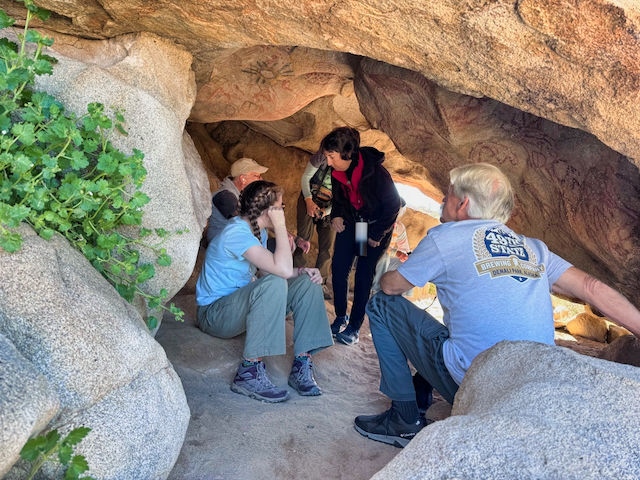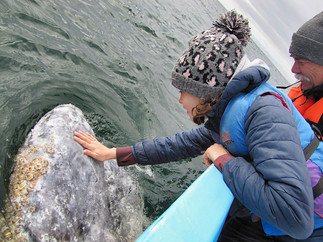
In the past, we'd considered bringing the Ciaowagen into Mexico. As you have noted, the subtitle of our blog talks about traveling North America in our RV. We'd spent considerable time all over the U.S. and Canada, but though we'd been close to Mexico (including a stones throw across the Rio Grande) we'd never actually crossed the border.
However, the more we looked into it, the less of a good idea it seemed. You have to get special vehicle insurance, services are limited in case of accident or breakdowns, and in recent years the crime rate has climbed.
As an alternative, we decided to sign up for a week-long, small-group van tour of the Baja Peninsula, offered by a company called Baja Custom Tours. We left our RV at the San Diego KOA, and early on the morning of February 15th drove the Fittata to the home of Mike Essery, our wonderful tour guide. NOTE: some of the pictures in this blog entry were taken by others and shared.

There we met up with our fellow travelers:
Mike Essery (driver and guide)
Graham Mackintosh (guide, Baja explorer and author)
Steve and Anne Walsh
Ron Edrozo and Pat White
Rachel Woodfield and her two daughters Lily (14) and Laurel (11)
Most of the other travelers were San Diego-area locals, and three of them had been firefighters. Rachel was a marine biologist. We were the sole out-of-towners. It was a great group, and we all got along famously throughout the week.

In addition to running his tour company, Mike works in residential real estate in southern California. Graham originally comes from England, but has lived in the U.S. and Baja for almost 40 years. He was super knowledgeable about plant and animal life and the geology of Baja. Shortly after he arrived in Baja, in his late 20s, he decided to hike the entire peninsula, finding water and his own food along the way, The trip covered almost 3,000 miles and 500 days, documented in his book "Into a Desert Place." Now 72, he's lived a very interesting life, including working for 6 months as a regular extra on James Cameron's film Titanic, and taking (and writing about) more adventures including traveling Baja with a burro.
The first day we drove over 400 miles, crossing the border in Tijuana, driving to the eastern edge of the Baja Peninsula on a toll road, then heading south along the Sea of Cortez to the small hamlet of Cataviña where we stayed the night. The Baja terrain is mostly desert and mountains. We explored the area the next morning after breakfast, noting cacti and trees that were similar to, but different than, the cacti we have in the American Southwest. These included the Cirio, which looks like a long tapering candle...

...the Cardon, which is similar to a Saguaro but which branches differently...

...and the Elephant Tree.

There were some other weird (but striking) plants we couldn't identify.

We hiked up a hill to explore a small cave with ancient paintings.


After that, we climbed back into the van and drove to Guerrero Negro, on the Pacific Ocean and our home for the next two days. One thing we appreciated was that Mike (who has a second house in Baja) knew all his vendors well so we always got excellent and friendly service. The food was also great, and ranged from authentic restaurants to a food truck known to prepare the best fish tacos in town. Luckily, we arrived a little after noon and did not have to experience the normal noon time rush .

Guerrero Negro was where we would spend two days visiting with the local grey whales. The whales have the longest migration of any animal in the world, traveling 12,000 miles from the Bering Sea and hugging the coasts of Alaska, Canada, and the U.S. until they arrive four months later at Scammon's Lagoon. There, females are impregnated or, if already pregnant, give birth to their calves and fatten them up before the long journey back to the Arctic. There are two parts of the lagoon: the inner lagoon ("2" in the picture below) where the moms and babies hang out, and the outer lagoon ("1") where the males tend to gather and protect the pod from predators trying to enter the lagoon mouth.


Each of the two days, we boarded pongas, small boats holding 12-15 people and operated either by local tour operators or fisherman, and took a fast (and chilly) 15-20 minute ride out to where the whales hung out. Our group fit into one ponga - there were probably 6-7 total spread out over a wide area.

As we got closer, we saw grey whales breaching near the boats.

Sometimes they would "periscope" up, rotating their head and eyes around to check out what was going on.
The grey whales are not scared of humans at all. As a matter of fact, they are quite curious and friendly, coming right up to the boat on their own.

In some cases, we could reach out and pet them! They felt rubbery - like day-old jello.
Each of our two trips to see the whales were magical! If we ever go whale watching again and just see distant spouting or surfacing, it won't be nearly as exciting.
On our way back, we passed a large barge holding salt. To get to the whale docks, we had to pass through a large commercial salt production facility where seawater is pumped into shallow lagoons which evaporate over 2-3 years. The salt is then bulldozed, ground up and prepared for shipping.

After our our first whale trip, we visited a preserve that is trying to bring back endangered pronghorn antelopes.
We also visited a beautiful dune area, where we all climbed around and some jumped off!
We next drove east across Baja to the Gulf of California and the small, beautiful village of Bahia de Los Angeles ("Angel's Bay") where we would spend two more nights. Bahia is where Mike has his second home. As you descend toward the coast you can see the whole bay laid out in front of you.

We checked into our local hotel, and walked along the beach before sunset.
The next morning the van brought us to Mike's house, where we boarded two pongas for a tour of the bay and its islands.


There were many birds, such as ospreys (with their large nests), cormorants, pelicans, seagulls, yellow and blue footed boobies, and great blue herons in their rookery holding vigil on their nests..
Dramatic rock formations and colorful cacti lined the shores.
One island, nicknamed Skull Island, stands out. It's been made white by being covered with hundreds of years of bird guano.
We also came on a group of sea lions lying on their backs in the water with their flippers stuck up in the air. It's a behavior seen regularly, but its purpose is not clear.

Returning to shore, we basked on the beach in front of Mike's house in the late afternoon. We had a wonderful meal prepared by a couple of his neighbors (with "to-die-for" flan at the end).

We topped off the day with a bonfire after dark.

Our final two days were taken up primarily with traveling north to the U.S. The first night we overnighted at the village of San Quinta, where we were able to hike the beautiful isolated beach by our hotel, watching the waves breaking and approaching the beach frothing all along the way.

We crossed the border on Thursday, February 22nd. Fortunately, Mike had picked a less-used crossing, and we only had to wait five minutes or so. For other, more crowded crossings like Tijuana, the line can be hours long.
We drove back to Mike's house, and after many goodbye hugs, we got into the Fittata to drive back south to our campground.
It was time to start our exploration of the California coast. More about that in our next blog post!













































Comentários